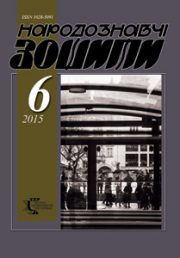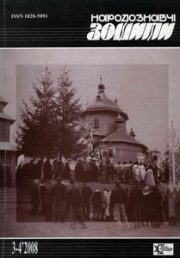The Ethnology Notebooks. 2021. # 1 (157), P. 28—39
УДК 398:[7.041:355.425.4-05]”19″(477.8)
DOI https://doi.org/10.15407/nz2021.01.028
Oksana CHIKALO
- ORCID ID: https://orcid.org/0000-0002-1636-3397
- candidate of Philological Sciences,
- senior researcher,
- Institute of Ethnology of the National
- Academy of Sciences of Ukraine,
- department of Folklore,
- 15, Svobody Avenue, 79000, Lviv, Ukraine,
- e-mail: ochikalo@yahoo.com
Subject of study. The article analyzes the image of the insurgent hero, which is central to the folk tales of the 1940s and 1950s. The purpose of the publication is to trace the typology in the form of return. Identify the established features and new elements, trace how the semantics of the form is formed under the influence of socio-historical factors. Consider its interpretation in folk prose.
The object of research are folk stories recorded in Prykarpattia and Volyn during 2018-2019. These are narratives about the national liberation struggle of the middle of the twentieth century, which are carried by the participants and witnesses of this struggle, as well as their descendants.
Actuality of theme. The topic of the article is not accidental, because for hundreds of years and to this day, in the popular consciousness, they have tried to create the absence of an unhappy, amorphous, image of the minority Ukrainian saloid. Hence the relevance of this intelligence, because, first, recorded and introduced into scientific circulation of new field materials relating to the events of the mid-twentieth century. In them in a national reception the image of the Hero of the XX-th century appears. Secondly, the writing of such an article is due to the need to trace how this image has evolved in different layers of folklore. Third, it is interesting to consider how the activities of real historical figures – prototypes of folk heroes – are recorded in historical sources and oral tradition. Fourth, given the laws of folk art, the image of the hero-warrior, the hero-defender of the XXI century is now based on the rice formed in the last century. Therefore, this intelligence is important for future research on the image of the hero in modern greeting.
The article synthesizes methods subordinated to the purpose of the research: structural-semiotic and structural-typological. Based on the analysis of the structural parts of narratives, figurative system, they allow their analysis in diachrony. With the help of the historical-genetic method, the image of the Ukrainian insurgent, a warrior-defender of the native land, evolved. The method of field research is useful, which allowed to record new stories about the activities of the UPA and its heroes.
Keywords: image, insurgent, narrative, motive, typology, innovation, semantics, diachrony, tradition.
REFERENCES
- Kostyuk, I. (2012). Mythological hero: origin, purpose, functions. Bulletin of the Lviv National Academy of Arts (Issue 23, pp. 376—385). Lviv [in Ukrainian].
- Hnatyuk, V. (1910). Folk tales about opryshky. Ethnographic collection (Vol. 26, p. VIII). Lviv [in Ukrainian].
- Sokil,V. (2003). Ukrainian historical and heroic legends: structural-semantic and poetic aspects. Lviv [in Ukrainian].
- Hnatyuk, Volodymyr. (Ed.). (1910). Folk tales about opryshky. Ethnographic collection (Vol. 26). Lviv [in Ukrainian].
- Tishchenko, V. (Ed.). (1968). People about the Kobylytsia: A collection of folklore works. Kyiv [in Ukrainian].
- Franko, I. (1986). Lukyan Kobylytsia. An episode from the history of the Hutsul region in the first half of the XIX century. Collection of works: in 50 vol. (Vol. 47, pp. 248—288). Kyiv: Naukova dumka [in Ukrainian].
- Kuzmenko, O. (2009). Rifleman’s singing: folklorism, folklorization, folklore. Lviv [in Ukrainian].
- Myshanych, S. (2003). Near the sources of folk prose. Folklore and literary works (Vol. 1, pp. 288—312). Donetsk [in Ukrainian].
- Britsyna, O. (2010). XX century in the oral history of Ukrainians (notes on the historicism of folklore). In search of his own voice: oral history as a theory, method and source (Pр. 135—143). Kharkiv [in Ukrainian].
- Information reference. Anti-German actions of the Ukrainian Insurgent Army of 1943—1944 (based on German, Soviet and Ukrainian documents). Retrived from: http://neskorena-nacia.com.ua/novyny/437-antynimetskyi-front-upa-1943-1944.html [in Ukrainian].
- Vyatrovych, V., Zabily, R., & Derevyany, I. (2011). Ukrainian Insurgent Army. History of the Unconquered. Lviv: Center for Liberation Movement Studies [in Ukrainian].
- ВО-4 «Hoverla». Retrived from: https://uk.wikipedia.org/wiki/% D0%92% D0% 9E-4_%C2%AB%D0%93% D0%BE%D0%B2%D0%B5 % D1% 80% D0% BB% D0% B0%C2%BB; The Way of Victory (Published by the UPA «Hoverla»). Retrived from: http://ounuis.info/archive/library/Newspapers/shliakh-peremohy-vydannia-vo-upa-hoverlia.html
- Levchuk, O. (2009). Color code of folklore formation of a horse and its symbolic significance in Ukrainian folk art. Mythology and folklore, 1 (2), 29—36 [in Ukrainian].
- Yankovska, J. (2016). Reflection of the archetypal image of the shirt in the Ukrainian literary prose of the 30—60s of the XIX century. Literary process: methodology, names, trends: сollection of scientific works. Philological sciences, 7, 194—199. Kyiv [in Ukrainian].
- Lunyo, E. (Ed.). (2005). Yavoriv region in the insurgent struggle: Stories of participants and eyewitnesses (Vol. 1): Nakoneczne First. Nakoneczne Second. Lviv: Litopys [in Ukrainian].
- Chikalo, O. (2009). Historical songs-chronicles of the twentieth century: the traditional plot and innovative ideological and thematic content. Ethnographic notebooks, 1—2, 184—191 [in Ukrainian].
- Sokil, G. (2004). Insurgent songs — a heroic chronicle of the Ukrainian people. Will and Motherland, 2—3, 146—152 [in Ukrainian].






